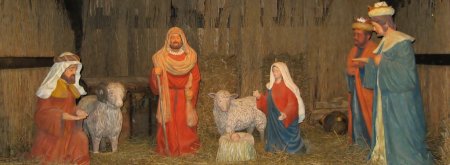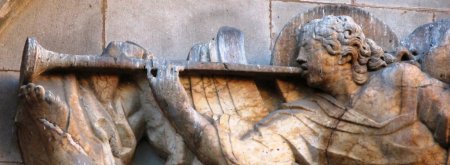The Original Christmas
It has spawned a multitude of powerful sermons and a few carols. It is there in our English translations of the Bible and yet it has been long known that it is not a correct representation of the text.
It is an interpretation based on English culture in the days of King James I. Middle Eastern experts have known the truth (and written on it); archaeologists have exposed it by excavation of buildings from the time of our Lord; even Jeremy Bowen (of the BBC) has got it right (mind you, he's another Middle Eastern expert).
I refer to the clause, 'because there was no room for them in the inn' (Luke 2:7). We all know the imaginary scenario of them knocking on the door and ending up in a cave behind the inn. But this does not resemble the cultural and historical reality.
Going Home
Aside from the fact that an inn was probably unlikely in Bethlehem, as it was not on a significant route between towns, it is usually forgotten that they were going 'home'. This was Joseph's home town and Mary's family lived not too far away. Can you imagine the family subjecting them to such conditions? What would we do if faced with such a scene? Wouldn't we move out of our bedroom and let the mother have our bed, etc.? Even with strangers, it is insulting to them to imagine they would treat a pregnant mother like that.
So, What is the Reality?
Kenneth Bailey, a specialist in Middle Eastern New Testament Studies, has written and spoken on this subject frequently. The key is the word 'inn'. In 1611, it was normal for travellers to look for accommodation in an inn and this obviously influenced the translators. The surprising aspect is that they still think in that way! As far as I can see, all the translations and paraphrases stick with that wording. So, let us look at the evidence.
The Greek word used by Luke is kataluma. When he refers to an inn – for example, in the parable of the Good Samaritan (Luke 10) – he uses pandeion. In contrast, kataluma is the word he used of the guest room in which the Lord met with his disciples. This arrangement in Middle Eastern homes is still used today. This writer has had the privilege of using such a room in a house with a group of friends. It is a well-recognised part of a home.
This situation has been well recognised for many years. A missionary to the Lebanon in 1857, William Thomson, described the type of house which was still used then and conformed to the biblical description. A German writer, Gustaf Dalmann, published several volumes on life in Palestine nearly a century ago and included graphics of these houses.
How Did This Work Out?
The edict by Caesar Augustus meant that Bethlehem was 'invaded' by many families who had, like Joseph, moved out in previous years. They had to return to their family homestead for the census. Joseph and Mary had to travel from the north of the country and so were probably among the last to arrive. The upstairs guest rooms were no doubt full to overflowing.
When Joseph and his highly pregnant wife arrived at their relatives' home, there was no room in the guest room. It was probably bursting at the seams and would have been inconvenient for the birth that was apparently imminent.
Downstairs was the family room, where the family ate, talked and slept. But, adjacent to this, was an area used by the animals, especially when it was too cold for them outside. It had the added advantage of generated warmth from the animals for the living room!
Here was an area that could be cleaned out and made available to Joseph and Mary with the facilities of the living room on hand. The manger consisted of a bowl hollowed out in a shallow wall from which the animals ate their fodder. Sometimes the animals' area was lower than the living accommodation and the troughs would be in the floor of the main room.
Another writer on this theme, Ben Witherington, points out another fascinating point. The family made the delivery room out of an area that was already ceremonially unclean. This point is reflected in Luke 2:22, which refers to 'when the time of their purification was up…'
Sorry that this may undermine some very powerful sermons about 'No room in the inn', but we must be accurate in our representations of these matters. I've no doubt that, with a bit of ingenuity and divine wisdom, it would be easy to shift the bias of the appeal to welcoming the Lord into the heart of the family!
© 2008 Evangelicals Now
This item was originally published in the December 2008 edition of Evangelicals Now. It is published here by the kind permission of the editors. For a free sample issue or to subscribe to Evangelicals Now, click here.



